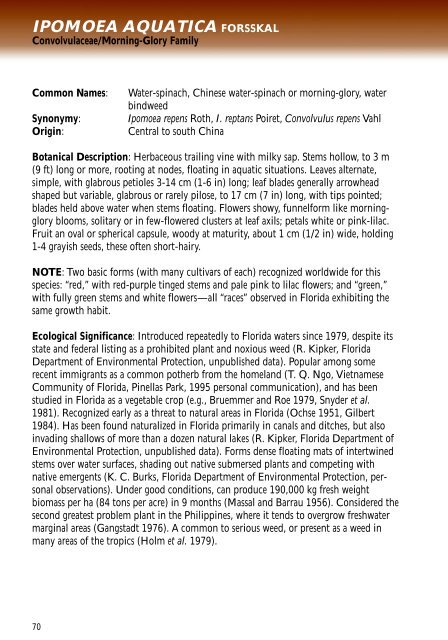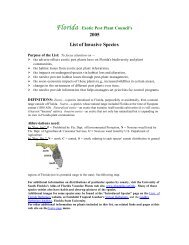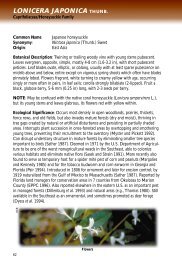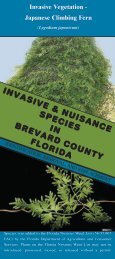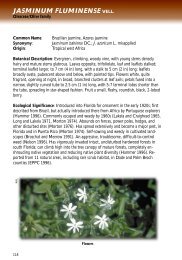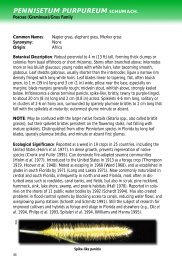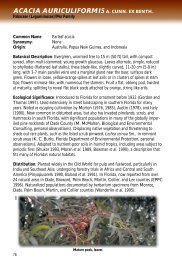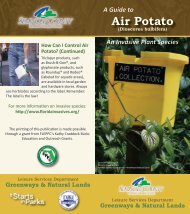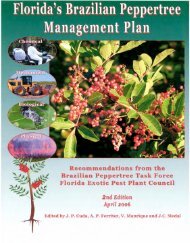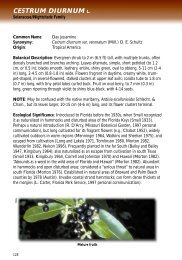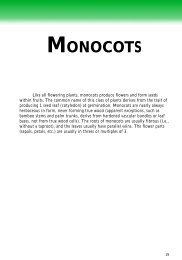DICOTS - Florida Exotic Pest Plant Council
DICOTS - Florida Exotic Pest Plant Council
DICOTS - Florida Exotic Pest Plant Council
You also want an ePaper? Increase the reach of your titles
YUMPU automatically turns print PDFs into web optimized ePapers that Google loves.
Ipomoea aquatica Forsskal<br />
Convolvulaceae/Morning-Glory Family<br />
Common Names: Water-spinach, Chinese water-spinach or morning-glory, water<br />
bindweed<br />
Synonymy: Ipomoea repens Roth, I. reptans Poiret, Convolvulus repens Vahl<br />
Origin: Central to south China<br />
Botanical Description: Herbaceous trailing vine with milky sap. Stems hollow, to 3 m<br />
(9 ft) long or more, rooting at nodes, floating in aquatic situations. Leaves alternate,<br />
simple, with glabrous petioles 3-14 cm (1-6 in) long; leaf blades generally arrowhead<br />
shaped but variable, glabrous or rarely pilose, to 17 cm (7 in) long, with tips pointed;<br />
blades held above water when stems floating. Flowers showy, funnelform like morningglory<br />
blooms, solitary or in few-flowered clusters at leaf axils; petals white or pink-lilac.<br />
Fruit an oval or spherical capsule, woody at maturity, about 1 cm (1/2 in) wide, holding<br />
1-4 grayish seeds, these often short-hairy.<br />
NOTE: Two basic forms (with many cultivars of each) recognized worldwide for this<br />
species: “red,” with red-purple tinged stems and pale pink to lilac flowers; and “green,”<br />
with fully green stems and white flowers—all “races” observed in <strong>Florida</strong> exhibiting the<br />
same growth habit.<br />
Ecological Significance: Introduced repeatedly to <strong>Florida</strong> waters since 1979, despite its<br />
state and federal listing as a prohibited plant and noxious weed (R. Kipker, <strong>Florida</strong><br />
Department of Environmental Protection, unpublished data). Popular among some<br />
recent immigrants as a common potherb from the homeland (T. Q. Ngo, Vietnamese<br />
Community of <strong>Florida</strong>, Pinellas Park, 1995 personal communication), and has been<br />
studied in <strong>Florida</strong> as a vegetable crop (e.g., Bruemmer and Roe 1979, Snyder et al.<br />
1981). Recognized early as a threat to natural areas in <strong>Florida</strong> (Ochse 1951, Gilbert<br />
1984). Has been found naturalized in <strong>Florida</strong> primarily in canals and ditches, but also<br />
invading shallows of more than a dozen natural lakes (R. Kipker, <strong>Florida</strong> Department of<br />
Environmental Protection, unpublished data). Forms dense floating mats of intertwined<br />
stems over water surfaces, shading out native submersed plants and competing with<br />
native emergents (K. C. Burks, <strong>Florida</strong> Department of Environmental Protection, personal<br />
observations). Under good conditions, can produce 190,000 kg fresh weight<br />
biomass per ha (84 tons per acre) in 9 months (Massal and Barrau 1956). Considered the<br />
second greatest problem plant in the Philippines, where it tends to overgrow freshwater<br />
marginal areas (Gangstadt 1976). A common to serious weed, or present as a weed in<br />
many areas of the tropics (Holm et al. 1979).<br />
70


